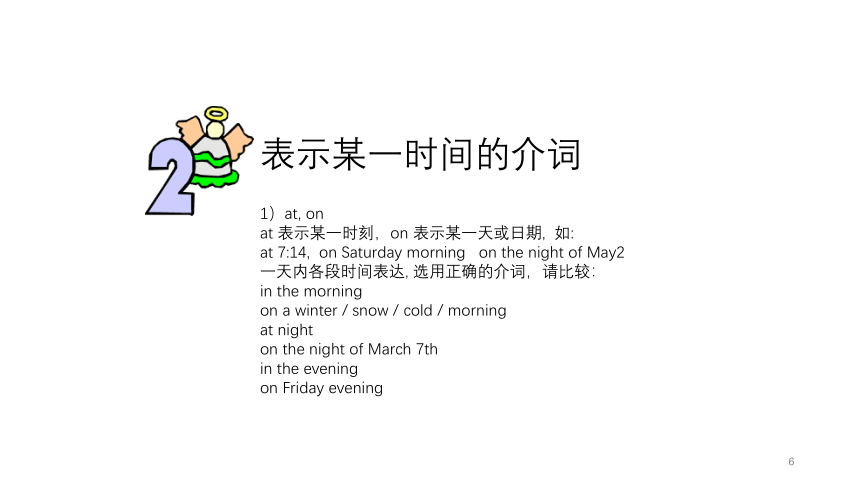2022年中考英语知识点学习介词专题课件(共有PPT19张)
文档属性
| 名称 | 2022年中考英语知识点学习介词专题课件(共有PPT19张) |  | |
| 格式 | zip | ||
| 文件大小 | 420.6KB | ||
| 资源类型 | 教案 | ||
| 版本资源 | 通用版 | ||
| 科目 | 英语 | ||
| 更新时间 | 2022-01-26 22:24:16 | ||
图片预览







文档简介
(共19张PPT)
初中介词专题
2
常用介词的用法
表示时间的介词
①in ,on ,at
in表示世纪,年,周,季节,在上午∕下午∕晚上∕白天等 。
例如:in the morning in May in 2012 in his forties in an hour
on 表示确定的时间, 某日,某日的上午,下午,晚上,星期几,或一般节日等。
例如:on Sunday on a rainy evening on May 4 on the night of May 4 on Teachers’ Day on Children’s Day
at 用于表示时间“点” .夜里.中午及某些词组中 例如 .at 4 o’clock at noon at that time at the end of at the age of
3
②by ,until∕till
表示期限时通常用介词by ,until ∕till by表示“不迟于” ,“在 ……之前” 例如:They had seen four English films by the end of last night.
Until ∕till到……为止 在肯定句中谓语动词要用延续性动词。
例如: I waited for my mum until she came home .
在否定句中,not … until译成“直到……才”谓语动词用非延续性动词 。 例如:I didn’t go to bed until my mum came home.
4
③in ,for ,during ,through
1)in 表示“在。。。。。。时间内”“在。。。。。时间后”
例如 :Do you work in the day time or at night I hear he’ll be back in a week.
2)for 后接一段时间,可与多种时态连用,如与现在完成时连用,谓语动词只能用延续性动词。
例如:She has worked there for 8 years.
3)during表示“在。。。。。。期间”,强调“自始自终”.
例如:During those days he asked a lot of questions .
5
4)through =from beginning to end “自始自终”“从头到尾 ”
例如:Dr. Bethune went on working through the night . 注:对“in+时间段”提问用 how soon
对“for+ 时间段”提问用 how long On the+身体硬部位 in the +身体软部位
④表示时间的起点用since 或from 例如:Tom has worked in the factory since three years ago. From now on ,I will learn English in the morning.
⑤in 和after
1)in “在。。。。。。以后”从现在算起,后接时间段,常用于将来时。 例如:We’ll be back in a week . He’ll arrive at Shanghai in two days .
2)after “在。。。。。。以后”,从过去算起, 后接时间段,常用于过去时。 例如:They got there after 8 hours. 后接时间点,常用于将来时。 例如:The plane is leaving after nine. 待续
6
表示某一时间的介词
1)at, on
at 表示某一时刻,on 表示某一天或日期, 如:
at 7:14, on Saturday morning on the night of May2
一天内各段时间表达, 选用正确的介词,请比较:
in the morning
on a winter / snow / cold / morning
at night
on the night of March 7th
in the evening
on Friday evening
7
2)before, by
before 表示某一时间之前,而by 表示到某一时间止,句中谓语动词多用完成时态。如::You must get up before six. 你必须六点之前起床。
By the end of last month the boy had got 4 “As”.
到上月底这个男孩已得了4个A.
(3)after , since
after 可以表示过去某一点时间之后,并不延续说话时间,和一般过去连用,而since表示从过去某时间开始的一段时间延续到说话时间, 与现在完时连用 如;
My father lived in Shanghai after liberation .
解放后我父亲住在上海.
Since the end of last year the lady has given five concerts.
自去年年底以来,这位女士开了五十场音乐会
8
(4)from…to, until / till
from----to表示从某一点时间到另一点时间的一段时间,而until till 表示某动作或状态延续到某点时间如:
My mother studied in Beijing University from 1960 to 1964.
从1960年到1964年我妈妈在北京大学学习。
My mother entered Beijing University in 1960, and studied there until 1964.
我妈妈1960年进入北京大学,一直学习到1964年。(但“从早到晚”常表达为from morning till night)
9
表示事物之间位置的介词
1)at, in
当事物被视作一点,不强调其空间常用介词at, 而表示空间内部用介词in, 如:
We’ll meet at the supermarket 我们在超市见面
I had to stay in the supermarket as it was raining hard
因为下大雨,我只好呆在超市里
*动词arrive 后接at ,表示较小的地方, 如: 车站、村庄等.后接in 表示较大地方,如: 城市,地区等
10
(2)in, to
in 表示事物在区域范围内的位置,to 表示事物对区域范围之外另一事物的位置,如:
Shanghai is in the east of China. 上海在中国东部
Japan lies to the east of China. 日本位于中国东面。
in front of 表示在前面,一般不在范围内,in the front of 表示在前面.在同一范围内。
11
(3)after, behind
after 指顺序先后 ,behind 指位置在某事物之后,相对于in front of 而言, 如:
He entered the classroom after the teacher
He hid himself behind the door 他在门后。
12
(4)on , in
on 表示“在某事物表面上”。如将事物看作空间,表示在其内部,用介词in。
There is a modern painting on the wall .
There is a modern painting on the wall .
(5)from , off 都表示“离开”
(6)above , over, below , under
over , under 表示垂直的上下关系,而above, below 仅表示位置上“高于”或“低于”, 不表示垂直关系。
(7)between, among
between 表示“两个事物之间”, among 表示“三者以上的事物之间”。
13
表示运动方向的介词
(1)into, inside , in 从外到内 如:
He went quickly into / inside the room.
He went quickly into / inside the room.
(2)out of 从里到外,相当于outside, 或从里向外,相当于from
She went out of from the office in a hurry 她匆匆走出办公室.
The boy watched the buses, cars and bikes out from the window .
这男孩透过窗观看外面的公交车、小汽车和自行车。
(3)on 在……表面,onto 到……上
A boat is on the river. 一条小船在河上。
He jumped onto a tree. 他跳上一棵树
14
(4)across 穿过一平面、through 穿过一空间
The boy kicked the ball hard and it moved across the grass.
这男孩用力踢球,球飞过草地。
The train moved fast through the tunnel. 火车飞驶隧道。
(5)The train moved fast through the tunnel. 火车飞驶隧道。
She walked to the bank 她步行到银行去
She swam towards the shore 她朝岸边游去。
☆☆☆☆☆
Choose the best answer.
【例1】The boat is passing B the bridge.
A. through B. below C. under D. across
【例2】Two planes are flying__B _ the city.
A. through B. over , C. on , D, below
【例3】Do you see the kite _D__ the building.
A. over B. cross C. on D. above
【例4】Is the street too narrow for the bus to go __A_
A. through B. across C. on D. in
15
☆☆☆☆☆
Choose the best answer.
( A )1. Hong Kong is ____ the south of China, and Macao is _____ the west of Hong Kong. A. in; to B. to; to C. to; in D. in; in
( A )2. Japan lies ______ the east of China.
A. to B. in C. about D. at
( D )5. There is a door___ the wall.
A. on B. to C. of D.in
( C )6. He put up a map ___ the back wall because there was a hole ___ it.
A. on; on B. at; in C. on; in D. on; at
咨询电话4008-039-036
16
介词
表示时间的介词
表示事物之间位置的介词
表示运动方向的介词
表示某一时间的介词
课堂小结
17
☆☆☆☆☆
Choose the best answer.
1. Tom sits____the classroom while John sits____the room.
A. in front of; at back of B. in the front of; at the back of
C. in front of; at the back of D. in the front of; at back of
2. Lucy sits____ the third row, ____Jim‘s left.
A. on; on B. in; at C. at; in D. in; on
3. Jiangsu is___ the east of China, but Japan is ___ the east of China.
A. to; in B. in; to . C. on; to D. to; on
4. Don‘t read ____ the sun. It‘s bad ___ your eyes.
A. in; to B. under; for C. with; to D. in; on
18
5. Hong Kong is ______ the south of China, and Macao is ______ the west of Hong Kong.
A. in; to B. to; to C. to; in D. in; in
6. Japan lies ______ the east of China.
A. to B. in C. about D. at
7. Look _______the map ______China _______the wall, please.
A after, of, in B at, of, in C after, in, on D at, of, on
8. He arrived _____ Guangzhou ____ noon.
A. in; in B. to; at C. in; at D. at; in
19
初中介词专题
2
常用介词的用法
表示时间的介词
①in ,on ,at
in表示世纪,年,周,季节,在上午∕下午∕晚上∕白天等 。
例如:in the morning in May in 2012 in his forties in an hour
on 表示确定的时间, 某日,某日的上午,下午,晚上,星期几,或一般节日等。
例如:on Sunday on a rainy evening on May 4 on the night of May 4 on Teachers’ Day on Children’s Day
at 用于表示时间“点” .夜里.中午及某些词组中 例如 .at 4 o’clock at noon at that time at the end of at the age of
3
②by ,until∕till
表示期限时通常用介词by ,until ∕till by表示“不迟于” ,“在 ……之前” 例如:They had seen four English films by the end of last night.
Until ∕till到……为止 在肯定句中谓语动词要用延续性动词。
例如: I waited for my mum until she came home .
在否定句中,not … until译成“直到……才”谓语动词用非延续性动词 。 例如:I didn’t go to bed until my mum came home.
4
③in ,for ,during ,through
1)in 表示“在。。。。。。时间内”“在。。。。。时间后”
例如 :Do you work in the day time or at night I hear he’ll be back in a week.
2)for 后接一段时间,可与多种时态连用,如与现在完成时连用,谓语动词只能用延续性动词。
例如:She has worked there for 8 years.
3)during表示“在。。。。。。期间”,强调“自始自终”.
例如:During those days he asked a lot of questions .
5
4)through =from beginning to end “自始自终”“从头到尾 ”
例如:Dr. Bethune went on working through the night . 注:对“in+时间段”提问用 how soon
对“for+ 时间段”提问用 how long On the+身体硬部位 in the +身体软部位
④表示时间的起点用since 或from 例如:Tom has worked in the factory since three years ago. From now on ,I will learn English in the morning.
⑤in 和after
1)in “在。。。。。。以后”从现在算起,后接时间段,常用于将来时。 例如:We’ll be back in a week . He’ll arrive at Shanghai in two days .
2)after “在。。。。。。以后”,从过去算起, 后接时间段,常用于过去时。 例如:They got there after 8 hours. 后接时间点,常用于将来时。 例如:The plane is leaving after nine. 待续
6
表示某一时间的介词
1)at, on
at 表示某一时刻,on 表示某一天或日期, 如:
at 7:14, on Saturday morning on the night of May2
一天内各段时间表达, 选用正确的介词,请比较:
in the morning
on a winter / snow / cold / morning
at night
on the night of March 7th
in the evening
on Friday evening
7
2)before, by
before 表示某一时间之前,而by 表示到某一时间止,句中谓语动词多用完成时态。如::You must get up before six. 你必须六点之前起床。
By the end of last month the boy had got 4 “As”.
到上月底这个男孩已得了4个A.
(3)after , since
after 可以表示过去某一点时间之后,并不延续说话时间,和一般过去连用,而since表示从过去某时间开始的一段时间延续到说话时间, 与现在完时连用 如;
My father lived in Shanghai after liberation .
解放后我父亲住在上海.
Since the end of last year the lady has given five concerts.
自去年年底以来,这位女士开了五十场音乐会
8
(4)from…to, until / till
from----to表示从某一点时间到另一点时间的一段时间,而until till 表示某动作或状态延续到某点时间如:
My mother studied in Beijing University from 1960 to 1964.
从1960年到1964年我妈妈在北京大学学习。
My mother entered Beijing University in 1960, and studied there until 1964.
我妈妈1960年进入北京大学,一直学习到1964年。(但“从早到晚”常表达为from morning till night)
9
表示事物之间位置的介词
1)at, in
当事物被视作一点,不强调其空间常用介词at, 而表示空间内部用介词in, 如:
We’ll meet at the supermarket 我们在超市见面
I had to stay in the supermarket as it was raining hard
因为下大雨,我只好呆在超市里
*动词arrive 后接at ,表示较小的地方, 如: 车站、村庄等.后接in 表示较大地方,如: 城市,地区等
10
(2)in, to
in 表示事物在区域范围内的位置,to 表示事物对区域范围之外另一事物的位置,如:
Shanghai is in the east of China. 上海在中国东部
Japan lies to the east of China. 日本位于中国东面。
in front of 表示在前面,一般不在范围内,in the front of 表示在前面.在同一范围内。
11
(3)after, behind
after 指顺序先后 ,behind 指位置在某事物之后,相对于in front of 而言, 如:
He entered the classroom after the teacher
He hid himself behind the door 他在门后。
12
(4)on , in
on 表示“在某事物表面上”。如将事物看作空间,表示在其内部,用介词in。
There is a modern painting on the wall .
There is a modern painting on the wall .
(5)from , off 都表示“离开”
(6)above , over, below , under
over , under 表示垂直的上下关系,而above, below 仅表示位置上“高于”或“低于”, 不表示垂直关系。
(7)between, among
between 表示“两个事物之间”, among 表示“三者以上的事物之间”。
13
表示运动方向的介词
(1)into, inside , in 从外到内 如:
He went quickly into / inside the room.
He went quickly into / inside the room.
(2)out of 从里到外,相当于outside, 或从里向外,相当于from
She went out of from the office in a hurry 她匆匆走出办公室.
The boy watched the buses, cars and bikes out from the window .
这男孩透过窗观看外面的公交车、小汽车和自行车。
(3)on 在……表面,onto 到……上
A boat is on the river. 一条小船在河上。
He jumped onto a tree. 他跳上一棵树
14
(4)across 穿过一平面、through 穿过一空间
The boy kicked the ball hard and it moved across the grass.
这男孩用力踢球,球飞过草地。
The train moved fast through the tunnel. 火车飞驶隧道。
(5)The train moved fast through the tunnel. 火车飞驶隧道。
She walked to the bank 她步行到银行去
She swam towards the shore 她朝岸边游去。
☆☆☆☆☆
Choose the best answer.
【例1】The boat is passing B the bridge.
A. through B. below C. under D. across
【例2】Two planes are flying__B _ the city.
A. through B. over , C. on , D, below
【例3】Do you see the kite _D__ the building.
A. over B. cross C. on D. above
【例4】Is the street too narrow for the bus to go __A_
A. through B. across C. on D. in
15
☆☆☆☆☆
Choose the best answer.
( A )1. Hong Kong is ____ the south of China, and Macao is _____ the west of Hong Kong. A. in; to B. to; to C. to; in D. in; in
( A )2. Japan lies ______ the east of China.
A. to B. in C. about D. at
( D )5. There is a door___ the wall.
A. on B. to C. of D.in
( C )6. He put up a map ___ the back wall because there was a hole ___ it.
A. on; on B. at; in C. on; in D. on; at
咨询电话4008-039-036
16
介词
表示时间的介词
表示事物之间位置的介词
表示运动方向的介词
表示某一时间的介词
课堂小结
17
☆☆☆☆☆
Choose the best answer.
1. Tom sits____the classroom while John sits____the room.
A. in front of; at back of B. in the front of; at the back of
C. in front of; at the back of D. in the front of; at back of
2. Lucy sits____ the third row, ____Jim‘s left.
A. on; on B. in; at C. at; in D. in; on
3. Jiangsu is___ the east of China, but Japan is ___ the east of China.
A. to; in B. in; to . C. on; to D. to; on
4. Don‘t read ____ the sun. It‘s bad ___ your eyes.
A. in; to B. under; for C. with; to D. in; on
18
5. Hong Kong is ______ the south of China, and Macao is ______ the west of Hong Kong.
A. in; to B. to; to C. to; in D. in; in
6. Japan lies ______ the east of China.
A. to B. in C. about D. at
7. Look _______the map ______China _______the wall, please.
A after, of, in B at, of, in C after, in, on D at, of, on
8. He arrived _____ Guangzhou ____ noon.
A. in; in B. to; at C. in; at D. at; in
19
同课章节目录
- 词法
- 名词
- 动词和动词短语
- 动词语态
- 动词时态
- 助动词和情态动词
- 非谓语动词
- 冠词
- 代词
- 数词和量词
- 形容词副词及其比较等级
- 介词和介词短语
- 连词和感叹词
- 构词法
- 相似、相近词比较
- 句法
- 陈述句
- 一般疑问句和否定疑问句
- 特殊疑问句及选择疑问句
- 反意疑问句
- 存在句(There be句型)
- 宾语从句
- 定语从句
- 状语从句
- 主谓一致问题
- 简单句
- 并列句
- 复合句
- 主谓一致
- 主、表语从句
- 名词性从句
- 直接引语和间接引语
- 虚拟语气
- 感叹句
- 强调句
- 倒装句
- 祈使句
- 句子的成分
- 句子的分类
- 题型专区
- 单项选择部分
- 易错题
- 完形填空
- 阅读理解
- 词汇练习
- 听说训练
- 句型转换
- 补全对话
- 短文改错
- 翻译
- 书面表达
- 任务型阅读
- 语法填空
- 其他资料
